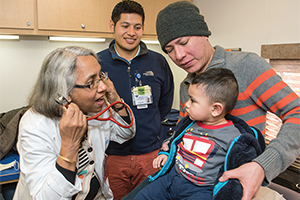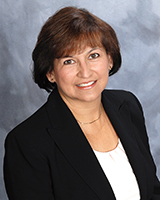By RENEE STOVSKY
Andres Velasco, 25, and his family immigrated to Richmond, Va., from El Salvador when he was 12 years old.

Andres Velasco, center background, provides medical interpretation as Dr. Usha Sundaram examines a patient in the Bon Secours Richmond Health System's Care-A-Van mobile clinic. Interpreters stand close to the patient, but protocol requires they do not disrupt eye contact between the patient and physician.
Initially, no one in his family spoke English. As Velasco and his brothers began to learn the language in school, they found themselves interpreting all sorts of things for their parents — directions for opening bank accounts, questions on job applications, instructions from doctors and nurses working on Bon Secours Health System's Care-A-Van, a free clinic on wheels that traveled to the family's church parking lot to serve the uninsured or underinsured.
"That's where we received all our primary care — physical exams, sick visits, vaccines, flu shots and more," he says.
His family was able to navigate its health concerns in that manner without major mishaps. But now that Velasco works as a medical interpreter on the Care-A-Van himself, he realizes just how lucky they were.
"Just a few weeks ago, we saw a diabetic patient with a foot injury. He was very sick and was sent to the emergency room," he says. "When he got there, he did not have a medical interpreter. A nurse examined him and said, 'You are good to go; just wait to see the doctor,' but he thought she meant 'you are good to go home,' and he left. I had to accompany him back to the ER and help him negotiate the whole process."
Anecdotes like that help validate the hard work that Patty Gavilan, a registered nurse who manages cross-cultural services for Bon Secours Richmond Health System, puts forth as coordinator of a comprehensive language services program. The program provides extensive medical interpreter training for employees, who then facilitate safe communication between patients with limited English proficiency and their providers.
Halting translation
Gavilan knows well how vulnerable non-English speakers can be when they don't fully understand what the doctor is saying.
"I have lived that journey," she says. Gavilan, a native of Colombia, arrived in New York City with her Spanish-speaking family at age 5 — the oldest of three children. "I had the responsibility of being the family interpreter, whether I wanted it or not," she says. "By age 6 I quickly learned English by going to school where no Spanish was spoken."

Gavilan
Gavilan remembers in particular a trip to the doctor's office with her mother, who was diagnosed as being severely anemic.
"I was 6, and I didn't know the word for anemia — much less what it meant. I was so afraid, but I was not going to tell that to a person with a white coat. So I'm sure I said something terribly incorrect," she says.
Proof of proficiency
That's why, when Gavilan, who is fluent in English and Spanish, joined Bon Secours as a critical care nurse in 2002, she gladly volunteered for the role of unofficial interpreter for Spanish-speaking patients. "I knew from experience the potential danger of language misunderstandings in health care settings," she says.
But her "aha" moment actually came in 2004, when the Joint Commission observed her providing nursing care to a Cuban patient. "They gave us great marks, but asked for documentation of proficiency. There was no documentation available to prove I was proficient," says Gavilan.
In 2007, she completed a 40-hour medical interpreter course at the Area Health Education Center in Arlington, Va., and earned a certification.
"The course made me realize there is much more to the role than just language proficiency. You also must be familiar with a specific medical glossary, culture and ethics," she says.
Train the trainer
Gavilan came back from the certification process determined to train other Bon Secours staffers to become medical interpreters.
"Initially, we tested 40 volunteers, and 20 passed proficiency tests by scoring in the 80th percentile or higher in two languages. Through a collaboration with the AHEC, we were able to train our first group of 15 bilingual staffers, but the cost was $550 per person off campus," says Gavilan. After that, to steward resources, Gavilan completed a "train-the-trainer class" and she now teaches the center's curriculum at the Bon Secours medical interpreter training program. The in-house training costs $200 per person, she says.
By 2009, Bon Secours had begun developing a dual role interpreter program, in which employees in a variety of roles in the health system — from nurses and technicians to security guards, dietary department workers, valet parking staff and more — are able to work their regular shifts but be available on an as-needed basis to serve as medical interpreters in patient care.
Gavilan, who is nationally certified in medical interpretation, estimates that Bon Secours Richmond has 50 medical interpreters in the system so far, scattered among four Richmond facilities and medical groups. Training is now being offered in the Virginia Beach, Va., area as well.
Grounded in values
In recent years, Bon Secours has modified the training program, expanding it to 50 hours and opening it to speakers of languages that reflect the diversity in the greater Richmond area. While Spanish is still the area's most common second language, Bon Secours now has employee volunteers trained as medical interpreters who speak Mandarin, Korean, Nepali, Japanese and Vietnamese. It recently trained an Arabic speaker who works in a private medical group affiliated with Bon Secours, says Gavilan.
Bon Secours made additions to the curriculum to anchor the training to its values of respect, compassion and justice. "We stress that this is our ministry — to provide 'Good help to those in need,' especially those who are most vulnerable," she says.
| Cross-cultural navigator promotes trust in Western medicine
In medical interpretation, overcoming linguistic obstacles is only part of the calculus for effective and safe communication. A trained interpreter is also a cultural broker between patients and providers.  As cross-cultural navigator for Bon Secours Richmond Health System, Maria Claudia Oystese, center background, makes sure that patients' cultural beliefs are respected. Here she fills in for a medical interpreter on the system's mobile health van as Dr. Usha Sundaram checks a patient's heart sounds. Which is why Bon Secours Richmond Health System expanded its medical interpreter program by hiring Maria Claudia Oystese, whose official title is "cross-cultural navigator." Oystese is an experienced, nationally certified medical interpreter. Together with Patty Gavilan, manager of cross-cultural services for the Richmond, Va., system, Oystese teaches medical interpretation training classes for Bon Secours employees. Oystese's main job is to ensure that cultural beliefs are respected when possible and do not hinder positive patient outcomes. She makes sure hospitalized patients with limited English proficiency understand their conditions, their care and their doctors' instructions. Oystese, whose father is from Holland and whose mother is from the Dominican Republic, grew up speaking Dutch and Spanish at home and learned English when she moved to the U.S. at age 16. She has a background in business and marketing, but she'd been working as a medical interpreter for several years when Bon Secours Richmond Health System tagged her in January 2014 as its first cross-cultural navigator. Oystese's main focus is a proactive one. She contacts hospitalized patients with limited English proficiency to assess their understanding of care and follow-up procedures and post-discharge instructions, and, she says, she "assures that diverse patient populations' needs are met in respectful and culturally competent ways." A recent example of her duties, Oystese recalls, involved an 11-year-old who was newly diagnosed with juvenile diabetes. The patient's mother, rather than listening to instructions for giving insulin to her child, insisted that the condition was caused by a "big fright." "I needed to ask the doctor to start from the beginning and explain diabetes and its origin," says Oystese. "And it was very important during that process that I maintained the relationship between the patient's mother and the provider, acting as a mouthpiece but not interfering with eye contact and body language. That's why we are called medical interpreters — not medical translators. They needed to connect so that trust could be established — and ultimately so the mother could be relied on to provide the needed at-home care." "Different cultures have very different beliefs about things like blood transfusions, vaccines, dietary practices, even religious jewelry," adds Gavilan. She recalls an instance in which a baby was to undergo an MRI, and her Puerto Rican mother became very upset when hospital personnel tried to take a medallion off the child's neck, since metal cannot be worn during the imaging process. "The problem was that the baby's grandmother had placed a St. Gerard medal around her neck that was supposed to be worn by tradition for the first year of life to keep the baby safe," says Gavilan. A solution was finally brokered — the medal was removed as the baby entered the MRI machine and replaced as soon as she exited from the other side. "There are situations like that — or more commonplace ones such as when a pregnant woman is in active labor or a patient is dying — where a telephonic interpretation system just doesn't work well," adds Gavilan. "Having a medical interpreter in the room — someone who can assess cultural breakdowns, reassure anxious patients, comfort grieving families — is just a more compassionate way to treat people." —Renee Stovsky |
Copyright © 2014 by the Catholic Health Association
of the United States
For reprint permission, contact Betty Crosby or call (314) 253-3477.